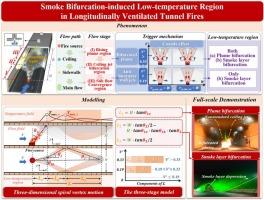Smoke bifurcation-induced low-temperature region in longitudinally ventilated tunnel fires: Phenomenon, modelling, and full-scale demonstration
IF 7.4
1区 工程技术
Q1 CONSTRUCTION & BUILDING TECHNOLOGY
引用次数: 0
Abstract
Understanding smoke behavior in tunnel fires is essential for designing effective smoke control and evacuation strategies. This study investigates the behavior of smoke spread and bifurcation in longitudinally ventilated tunnel fires through a combination of full-scale fire experiments and numerical simulations. The findings show that intense ventilation disrupts the continuity of the downstream smoke layer and triggers the smoke layer bifurcation. This process is characterized by a three-dimensional spiral vortex structure, involving both radial and longitudinal diffusion, driven by the combined effects of thermal buoyancy, inertial forces, and sidewall confinement. The smoke bifurcation leads to a redistribution of mass and heat within the smoke layer, forming a central low-temperature region beneath the tunnel ceiling. The range of the smoke layer expands with increasing tunnel aspect ratio and ventilation velocity but decreases with higher heat release rates. Finally, a theoretical model to estimate the length of low-temperature region is proposed and validated, accounting for the complex interactions between the Coanda effect, anti-buoyancy sidewall jets, and plume behavior. This work challenges the traditional one-dimensional smoke flow assumption and offers a new understanding of the complex three-dimensional nature of smoke transport in tunnel fires, providing a more robust foundation for tunnel ventilation design and emergency response planning.

纵向通风隧道火灾中烟雾分岔引起的低温区:现象、建模和全尺寸演示
了解隧道火灾中的烟气行为对设计有效的烟气控制和疏散策略至关重要。本文采用全尺寸火灾实验和数值模拟相结合的方法,研究了纵向通风隧道火灾中烟雾的扩散和分岔行为。结果表明,强通风破坏了下游烟层的连续性,引发了烟层的分叉。在热浮力、惯性力和侧壁约束的共同作用下,该过程以三维螺旋涡结构为特征,包括径向和纵向扩散。烟雾分岔导致烟雾层内质量和热量的重新分配,在隧道顶板下方形成一个中心低温区。烟层的范围随着隧道长径比和通风速度的增加而扩大,但随着放热率的增加而减小。最后,考虑到Coanda效应、反浮力侧壁射流和羽流行为之间复杂的相互作用,提出了估算低温区长度的理论模型并进行了验证。该研究挑战了传统的一维烟流假设,对隧道火灾中烟雾传输的复杂三维性质有了新的认识,为隧道通风设计和应急响应规划提供了更坚实的基础。
本文章由计算机程序翻译,如有差异,请以英文原文为准。
求助全文
约1分钟内获得全文
求助全文
来源期刊

Tunnelling and Underground Space Technology
工程技术-工程:土木
CiteScore
11.90
自引率
18.80%
发文量
454
审稿时长
10.8 months
期刊介绍:
Tunnelling and Underground Space Technology is an international journal which publishes authoritative articles encompassing the development of innovative uses of underground space and the results of high quality research into improved, more cost-effective techniques for the planning, geo-investigation, design, construction, operation and maintenance of underground and earth-sheltered structures. The journal provides an effective vehicle for the improved worldwide exchange of information on developments in underground technology - and the experience gained from its use - and is strongly committed to publishing papers on the interdisciplinary aspects of creating, planning, and regulating underground space.
 求助内容:
求助内容: 应助结果提醒方式:
应助结果提醒方式:


